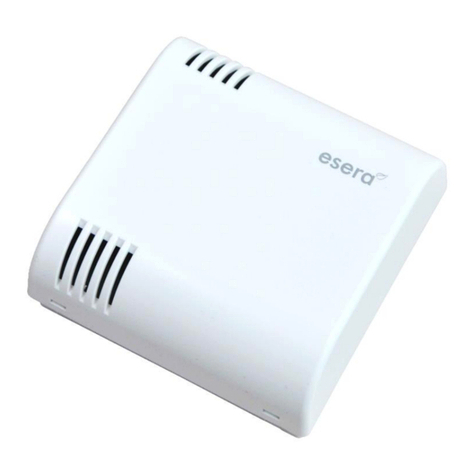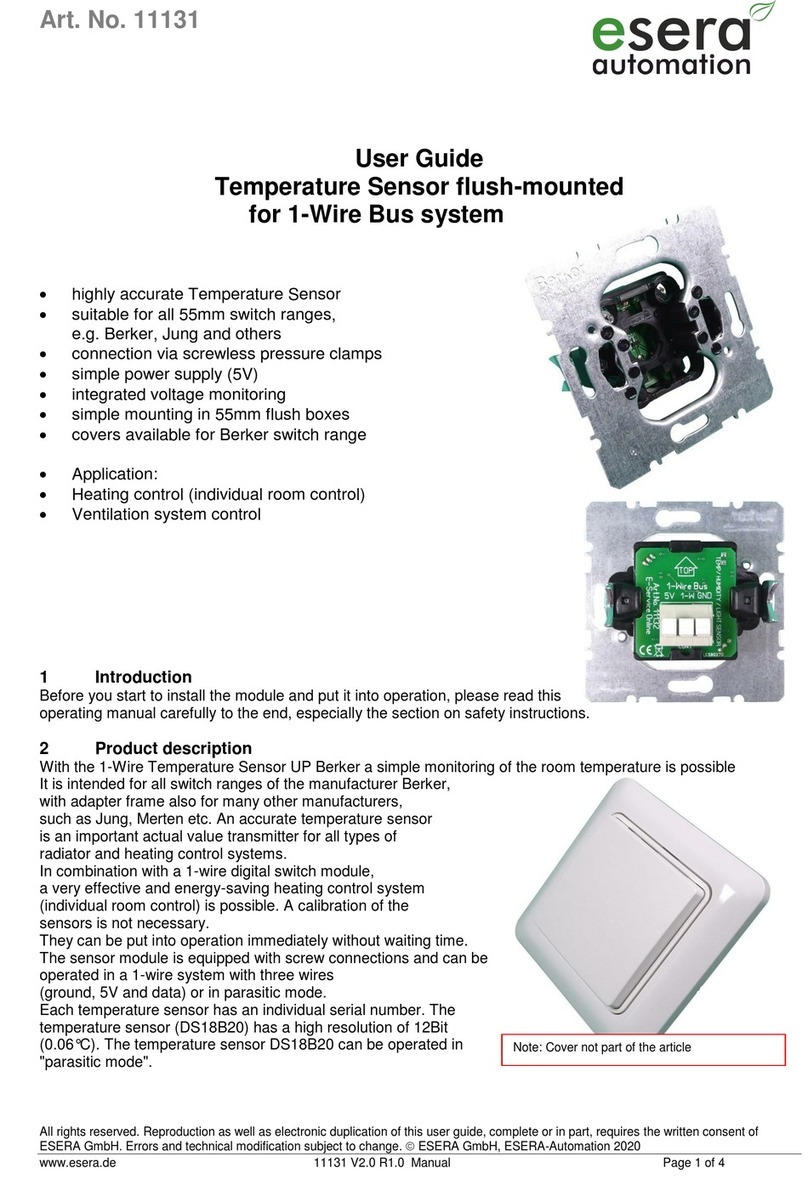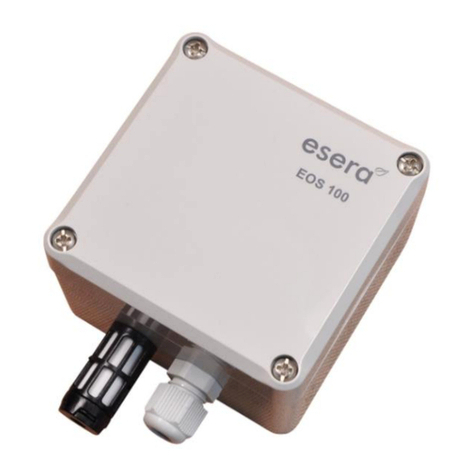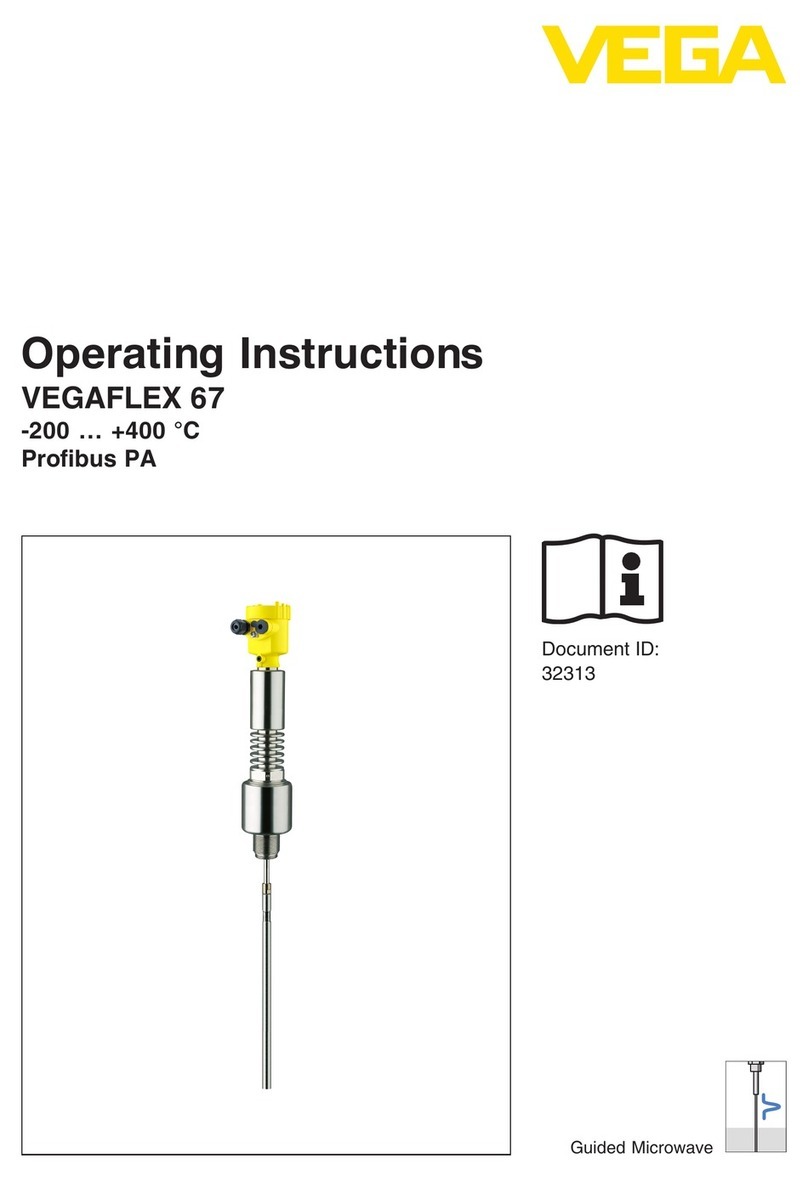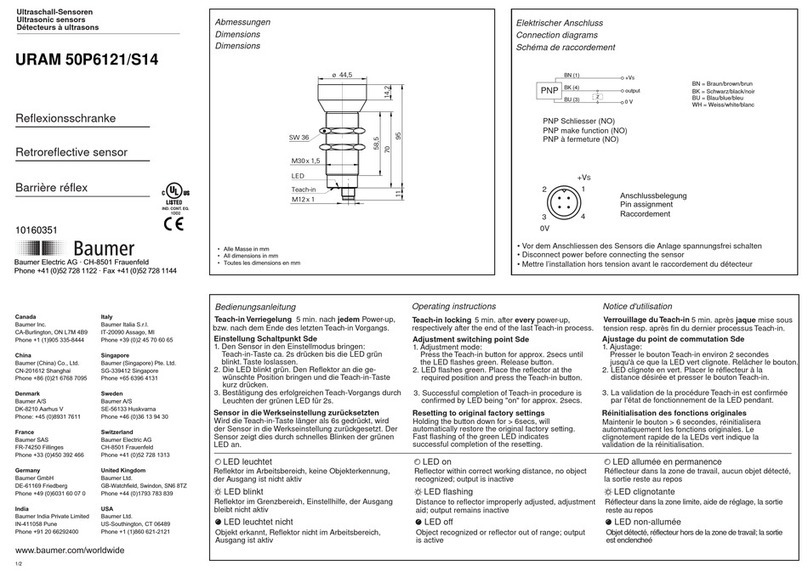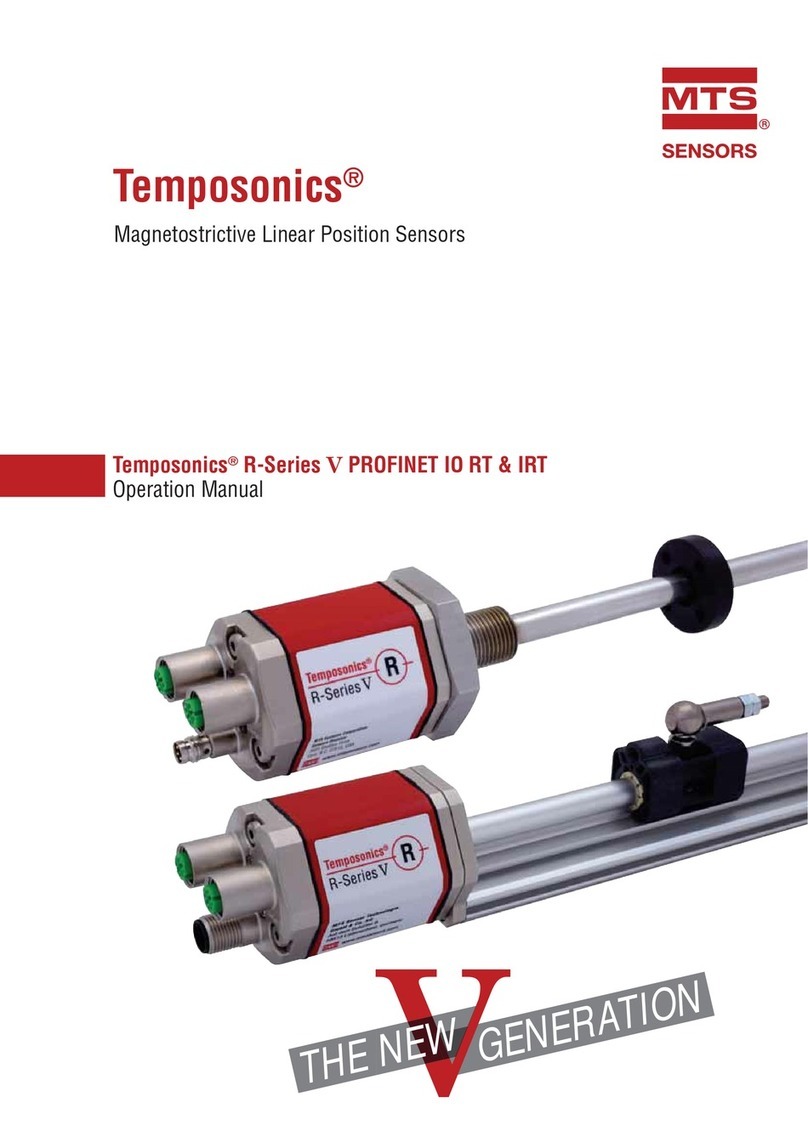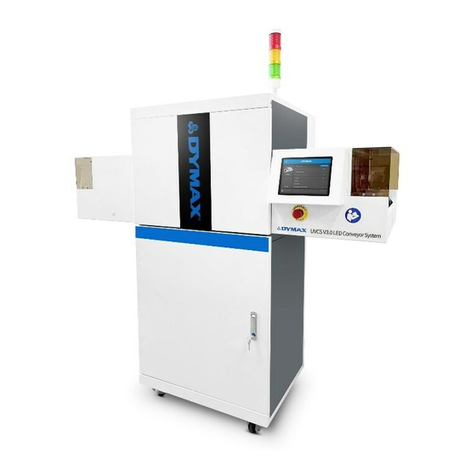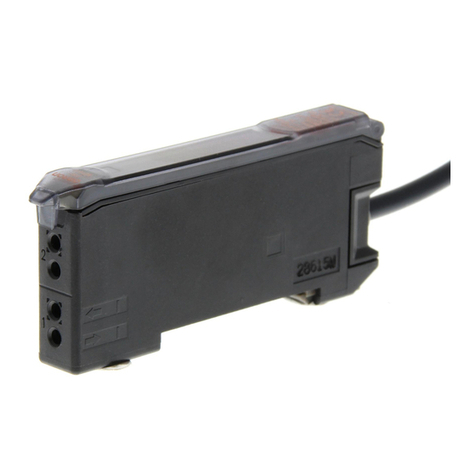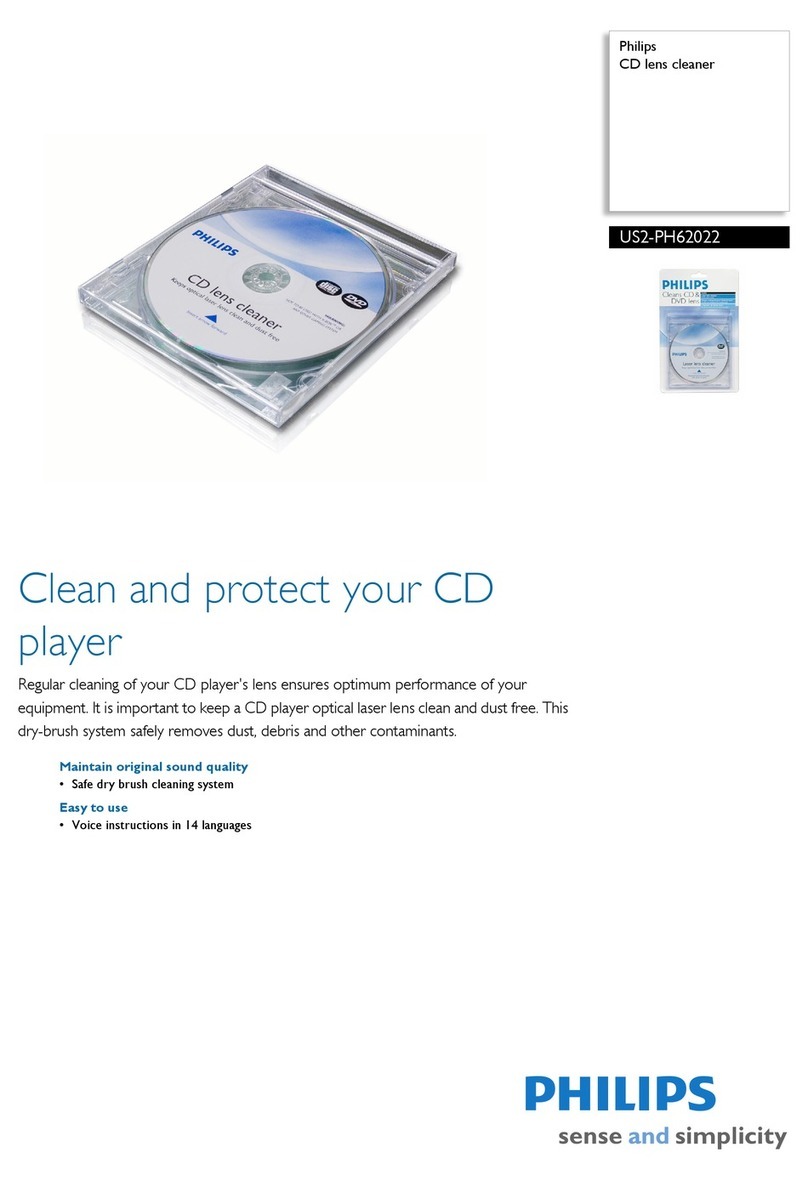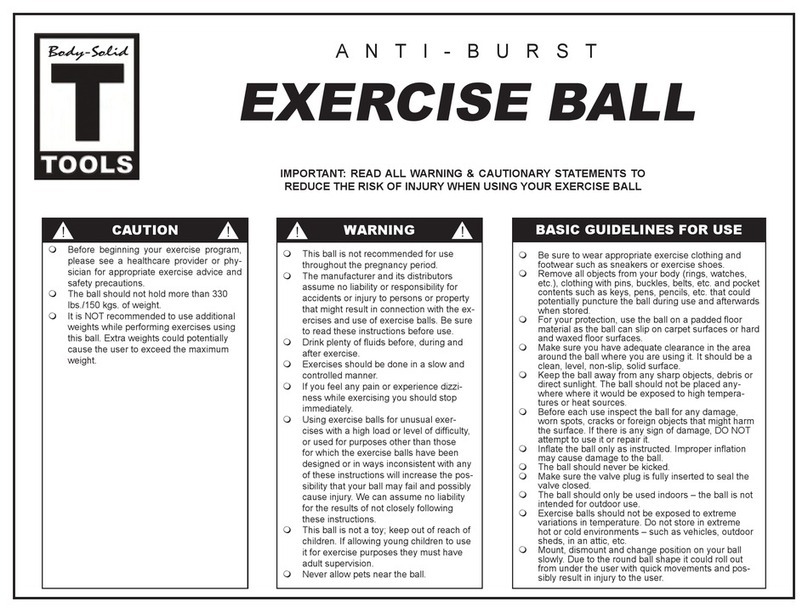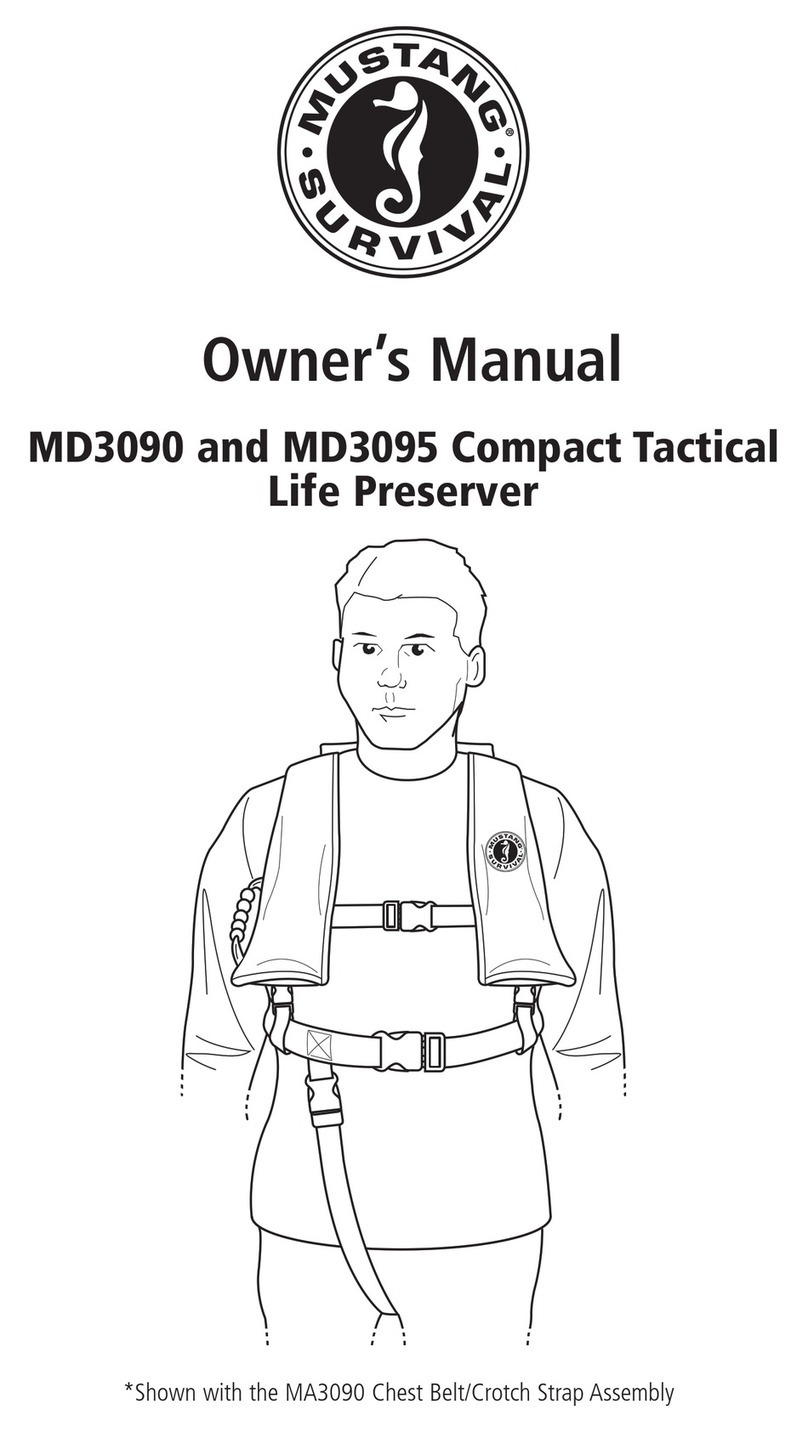esera DS18S20 User manual

All rights reserved. Reproduction as well as electronic duplication of this user guide, complete or in part, requires the written consent of
ESERA GmbH. Errors and technical modification subject to change. ESERA GmbH, ESERA-Automation 2020
www.esera.de 11119 V2.0 R1.0 Manual Page 1 of 4
Art. No. 11119
User Guide
1-Wire Temperature Sensor
Pressure-resistant 1/8 inch screw-in sensor
SEMOFLEX cable and RJ12 connector
1 Product description
The pressure-resistant temperature sensor with PUR connecting cable and 1/8" stainless steel sensor tube is
pressure-tight, chemically resistant and may be immersed in liquids that do not attack stainless steel (1.4571) in
the area of the sensor tube. The temperature sensor is ideally suited for high-quality applications in industry,
heating and measuring technology.
Individual 1-Wire sensors can be operated via adapter cable on a 1-Wire Adapter or 1-Wire bus coupler. For a
larger number we recommend using our 1-Wire Hub III and IV.
Sensor:
The sensor module can be integrated into a 1-Wire network via RJ12 plug connection. No calibration of the
temperature sensors is necessary. Each temperature sensor has an individual serial number.
Connection cable:
High-quality, shielded connection cable for industrial applications, available in three-pole design. Cable with
conductor cross-section 0.14 mm2, high-quality insulation made of extremely temperature and chemical resistant
TPE (neoprene). Colour coding of the cores according to DIN 47100, RoHS compliant.
The cable was specially developed for our temperature sensors to cover a wide temperature range with maximum
resistance to environmental influences.
Performance features
Temperature Sensor with screw-in thread 1/8 inch
High quality, Semoflex connection cable 2m
Wide temperature range from -40 to 125°C
Largely chemically resistant
Waterproof grouted
Resistant to alkalis and acids
(low concentrations)
Thermally formable for spiral
Typical areas of application
Industrial applications
Compressed air and hydraulic technology
Temperature sensor for heating systems
laboratory equipment, scientific equipment

All rights reserved. Reproduction as well as electronic duplication of this user guide, complete or in part, requires the written consent of
ESERA GmbH. Errors and technical modification subject to change. ESERA GmbH, ESERA-Automation 2020
www.esera.de 11119 V2.0 R1.0 Manual Page 2 of 4
2 Technical data Sensor
1-Wire module: DS18S20
Accuracy: +/- 0,5°C in the range of -10°C to 85°C
Resolution: 9 Bit, 0,5°C to 0,0625°C/Bit depending on readout method
Operating voltage: 5 V= (+/-5%)
Power consumption: approx..1mA
Connection cable: 2m
Mechanics: thread 1/8 inch
Dimensions: Immersion sleeve in front of thread: 20mm,
Thread height: 8mm
Wrench size: 14mm
Total length: 35mm (without cable)
bend relief: 47mm
ambient conditions (cable): Operation: moving -10 ... +60 °C, unmoved -40 ... +80 °C, briefly 100 °C
3 Auto-E-Connect® Support
The ESERA Auto-E-Connect® 1-Wire Plug and Play system will be used for the
1-Wire Bus supported. This enables fully automatic configurations of 1-Wire sensors
and actuators on the 1-Wire bus. It is optimized for industrial applications and
enables significant added value beyond the sensor and chip data.
The Auto-E-Connect function automatically recognizes ESERA chips, sensors and actuators, starts suitable
libraries and outputs fully formatted data.
The Auto-E-Connect functionality will be available from mid-2020 via 1-Wire Controllers, 1-Wire Gateways and
1-Wire ECO from ESERA available.
Further information on ESERA Auto-E-Connect can be found on the ESERA website, ESERA Config-Tool 3, or in
the download area for this article in the ESERA Webshop.
4 Pin assignment
The Western connector is assigned as follows (view of the cable, i.e. the contact surfaces of the connector):
Note, the sensor cannot be connected directly to the 1-Wire adapter because of different pin assignments!
Note: Basic information and tips on the 1-Wire Bus system can be found on the ESERA website at:
https://www.esera.de/1-wire-grundlagen/
5 1-Wire Network
For short connection lengths, no special requirements are placed on the cable used. With unshielded cable, a
longer connection length can be achieved in an undisturbed environment, since the capacitive bus load is lower.
A total length of 60 m and more can be achieved without additional measures.
In a disturbed environment, the cable should be shielded to improve the interference sensitivity of the system.
Due to the higher capacitive load, the maximum possible connection length is reduced.
The special feature of the wiring of the sensors is the "BUS technology": All sensors are operated in parallel on a
three-core cable, via which both the power supply and the data communication take place.
Increase the connection length:
The sum of all connecting cables should be less than approx. 60m to ensure safe operation. By connecting an
additional pull-up resistor with 4.7 ... 10 kOhm (line DATA against +5 V) the cable length can be increased, but
with a slight deterioration of the measuring accuracy due to the higher self-heating of the sensor.
1 Shielding or unoccupied
2 Ground
3 Dallas Data or unoccupied
4 Dallas Data
5 +5 V
6 +5 V or unoccupied

All rights reserved. Reproduction as well as electronic duplication of this user guide, complete or in part, requires the written consent of
ESERA GmbH. Errors and technical modification subject to change. ESERA GmbH, ESERA-Automation 2020
www.esera.de 11119 V2.0 R1.0 Manual Page 3 of 4
Art. No. 11119
6 Measuring Accuracy
The sensors are calibrated during manufacture and have a typical measuring accuracy of ±0.5 °K at
23 °C operating temperature. The accuracy deteriorates towards the upper and lower measuring range limits.
Further information can be found in the data sheet of the module on the homepage of the manufacturer.
As with all temperature measurements, however, the physical background must be taken into account to avoid
measurement errors, which have a significant influence on the precision of the measurement setup:
6.1 Thermal contact resistance of the target sensor
This measurement error occurs mainly with surface measurements. Good thermal contact can be remedied by
mounting in a bore hole, by using heat-conducting paste or by using heat-conducting adhesive.
6.2 Thermal Heat Dissipation Sensor Ambient Temperature
For surface measurements, the measurement setup should be thermally insulated from the environment, for
example with foam or mineral wool.
6.3 Thermal Heat Dissipation Sensor Connection Wires
This measurement error can be minimized, for example, by making the connecting cable as thin as possible and
made of material with poor thermal conductivity or by tempering the connecting cable with the measurement
object.
In principle, the highest measurement accuracy can be achieved by immersion in liquids or in a mounting hole.
On the other hand, an additional measurement error should be taken into account when measuring on surfaces.
7 Operating conditions
The sensor is designed for temperature measurement of gases or solids.
The temperature sensors are semiconductor sensors. The unhoused sensors are designed for temperature
measurements in the range from -55 ... +125 °C. These temperature values are limit data and must not be
exceeded or undercut, otherwise the component may be damaged.
8 Disposal information
Do not dispose of the device in household waste! Electronic devices must be disposed of in
accordance with the Directive on Waste Electrical and Electronic Equipment on local
Dispose of at collection points for old electronic equipment!
9 Safety instructions
When using products that come into contact with electrical voltage, the valid VDE regulations must be
observed, especially VDE 0100, VDE 0550/0551, VDE 0700, VDE 0711 and VDE 0860
All final or wiring work must be carried out with the power turned off.
Before opening the device, always unplug or make sure that the unit is disconnected from the mains.
Components, modules or devices may only be put into service if they are mounted in a contact proof housing.
During installation they must not have power applied.
Tools may only be used on devices, components or assemblies when it is certain that the devices are disconnected
from the power supply and electrical charges stored in the components inside the device have been discharged.
Live cables or wires to which the device or an assembly is connected, must always be tested for insulation faults or
breaks.
If an error is detected in the supply line, the device must be immediately taken out of operation until the faulty cable
has been replaced.
When using components or modules it is absolutely necessary to comply with the requirements set out in the
accompanying description specifications for electrical quantities.
If the available description is not clear to the non-commercial end-user what the applicable electrical characteristics
for a part or assembly are, how to connect an external circuit, which external components or additional devices can
be connected or which values these external components may have, a qualified electrician must be consulted.
It must be examined generally before the commissioning of a device, whether this device or module is basically
suitable for the application in which it is to be used.
In case of doubt, consultation with experts or the manufacturer of the components used is absolutely necessary.
For operational and connection errors outside of our control, we assume no liability of any kind for any resulting
damage.

All rights reserved. Reproduction as well as electronic duplication of this user guide, complete or in part, requires the written consent of
ESERA GmbH. Errors and technical modification subject to change. ESERA GmbH, ESERA-Automation 2020
www.esera.de 11119 V2.0 R1.0 Manual Page 4 of 4
Kits should be returned without their housing when not functional with an exact error description and the
accompanying instructions. Without an error description it is not possible to repair. For time-consuming assembly or
disassembly of cases charges will be invoiced.
During installation and handling of components which later have mains potential on their parts, the relevant VDE
regulations must be observed.
Devices that are to be operated at a voltage greater than 35 VDC / 12mA, may only be connected by a qualified
electrician and put into operation.
Commissioning may only be realized if the circuit is built into a contact proof housing.
If measurements with an open housing are unavoidable, for safety reasons an isolating transformer must be
installed upstream or a suitable power supply can be used.
After installing the required tests according to DGUV / regulation 3 (German statutory accident insurance
https://en.wikipedia.org/wiki/German_Statutory_Accident_Insurance) must be carried out.
10 Warranty
ESERA GmbH guarantees that the goods sold at the time of transfer of risk to be free from material and workmanship
defects and have the contractually assured characteristics. The statutory warranty period of two years begins from date of
invoice. The warranty does not extend to the normal operational wear and normal wear and tear. Customer claims for
damages, for example, for non-performance, fault in contracting, breach of secondary contractual obligations,
consequential damages, damages resulting from unauthorized usage and other legal grounds are excluded. Excepting to
this, ESERA GmbH accepts liability for the absence of a guaranteed quality resulting from intent or gross negligence.
Claims made under the Product Liability Act are not affected.
If defects occur for which the ESERA GmbH is responsible, and in the case of replacement goods, the replacement is
faulty, the buyer has the right to have the original purchase price refunded or a reduction of the purchase price.
ESERA GmbH accepts liability neither for the constant and uninterrupted availability of the ESERA GmbH or for technical
or electronic errors in the online offer.
We are constantly developing our products further and reserve the right to make changes and improvements to any of the
products described in this documentation without prior notice. Should you require documents or information on older
11 Trademarks
All mentioned designations, logos, names and trademarks (including those which are not explicitly marked) are
trademarks, registered trademarks or other copyright or trademarks or titles or legally protected designations of their
respective owners and are hereby expressly recognized as such by us. The mention of these designations, logos, names
and trademarks is made for identification purposes only and does not represent a claim of any kind on the part of ESERA
GmbH on these designations, logos, names and trademarks. Moreover, from their appearance on ESERA GmbH
webpages it cannot be concluded that designations, logos, names and trademarks are free of commercial property rights.
ESERA and Auto-E-Connect are registered trademarks of ESERA GmbH.
12 Contact
ESERA GmbH
Adelindastrasse 20
D-87600 Kaufbeuren
GERMANY
Tel.: +49 (0) 8341 999 80-0
Fax: +49 (0) 8341 999 80-10
www.esera.de
WEEE-Number: DE30249510
Table of contents
Other esera Accessories manuals
Popular Accessories manuals by other brands

Thermo Scientific
Thermo Scientific 310 Series manual
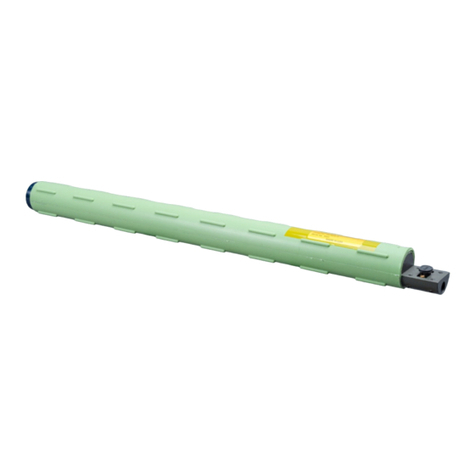
Applied Physics Systems
Applied Physics Systems 751 user manual
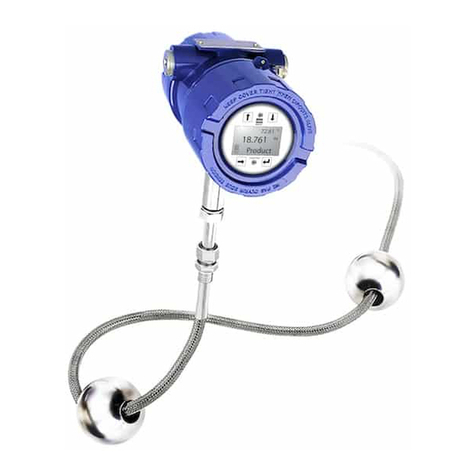
MTS Sensors
MTS Sensors Level Plus M Series Replacement guide

Ohmeda
Ohmeda Ohio Care Plus Operation and maintenance manual
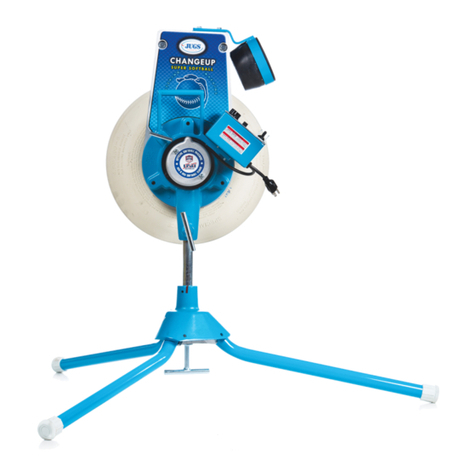
JUGS
JUGS Jr. owner's manual
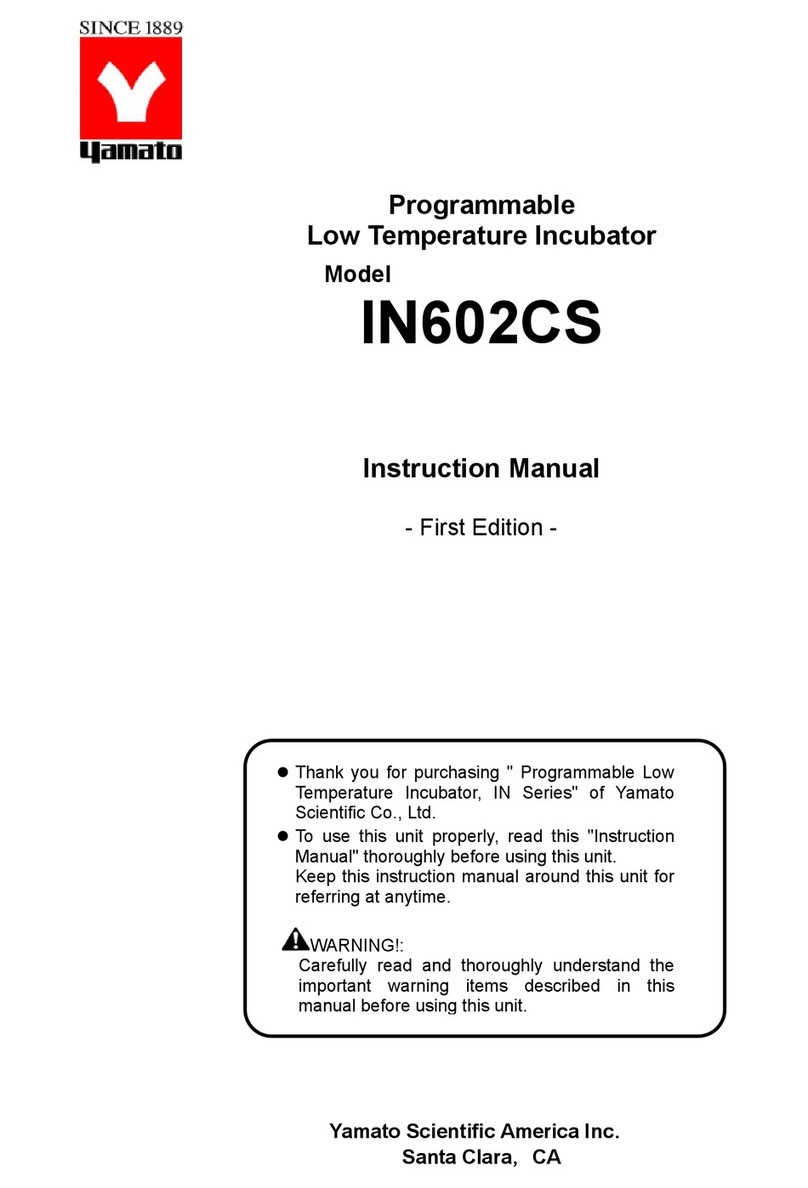
Yamato
Yamato IN602CS instruction manual
